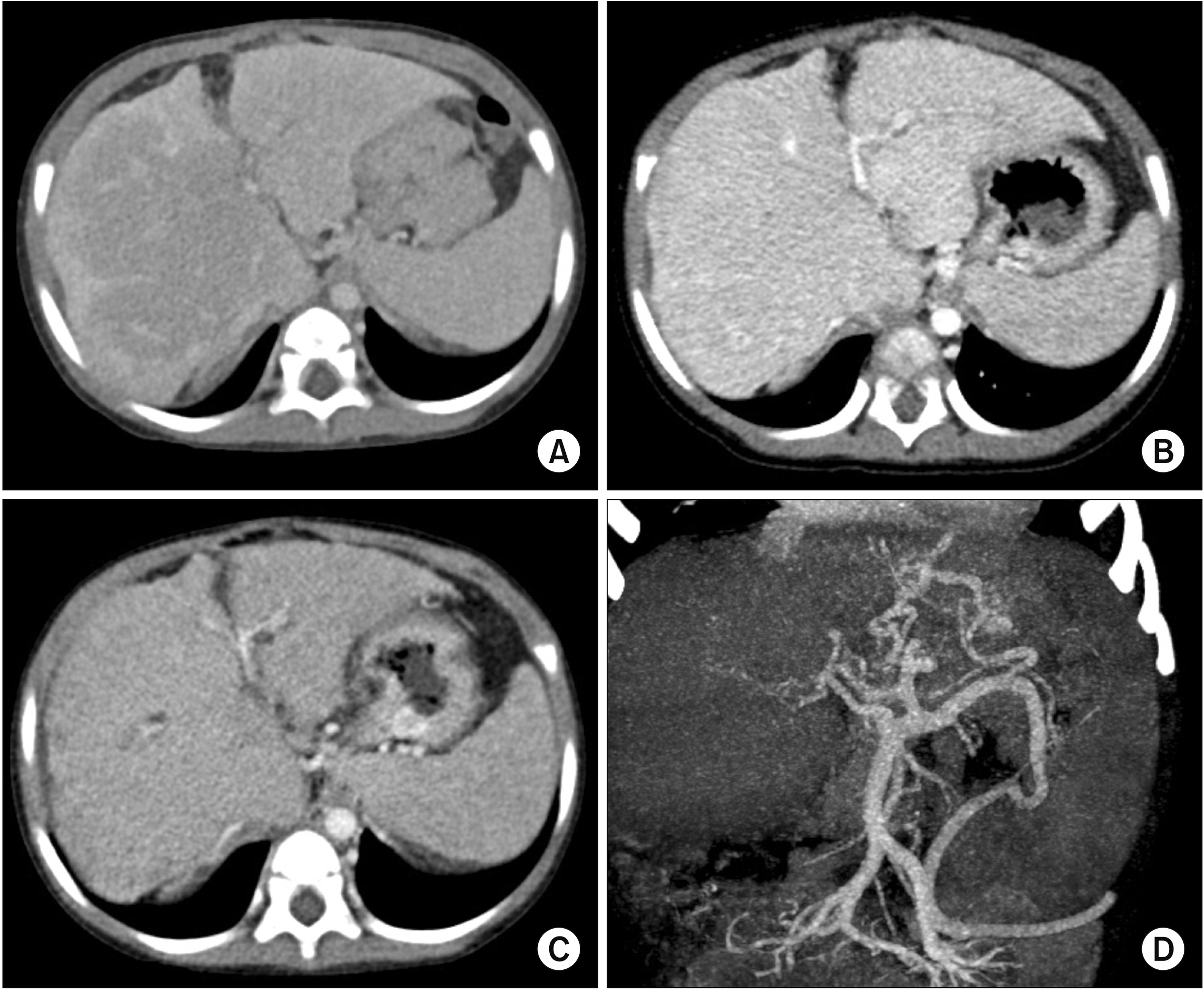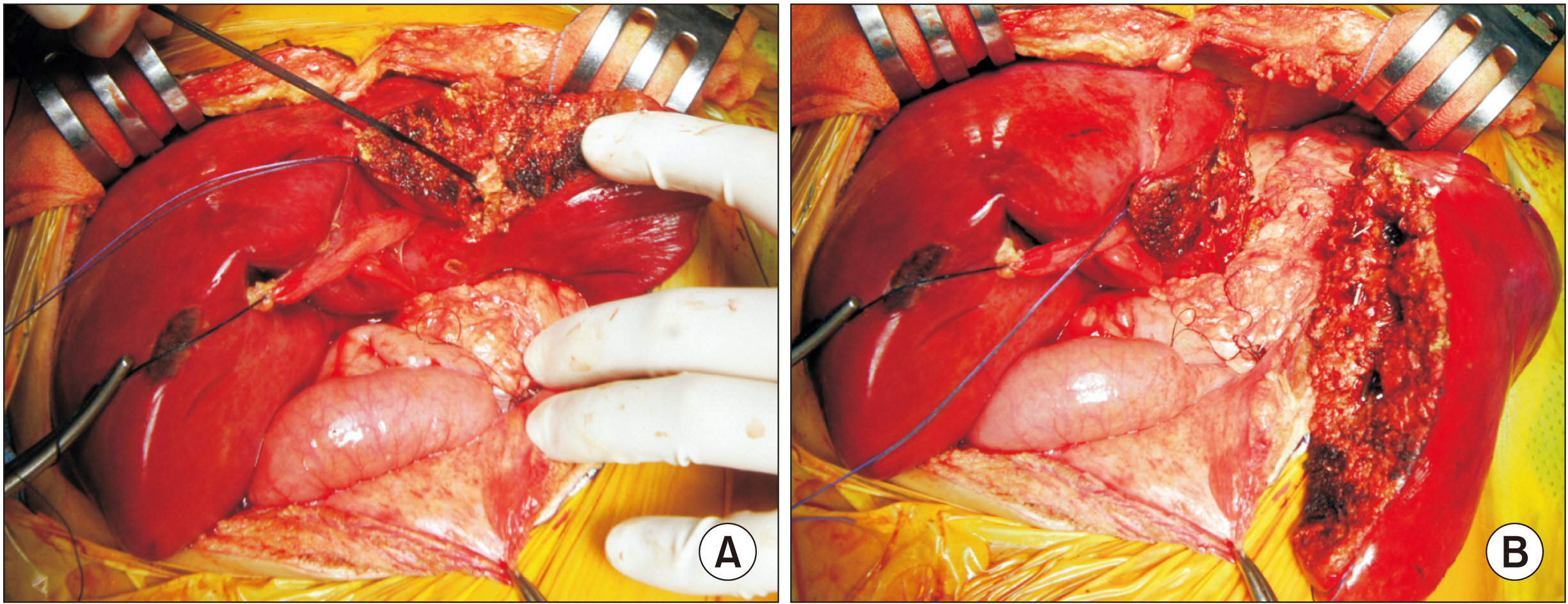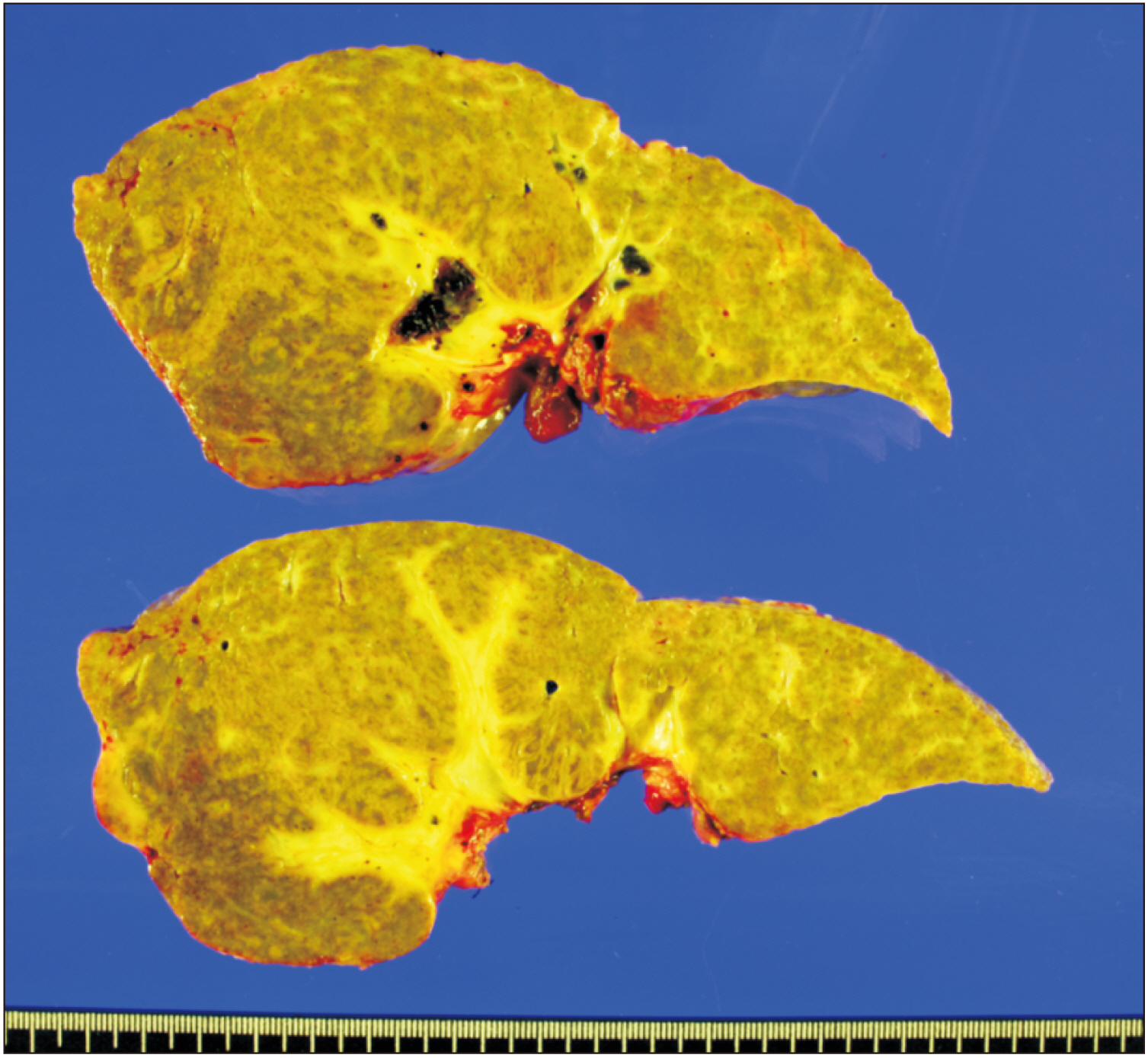Ann Hepatobiliary Pancreat Surg.
2021 Aug;25(3):431-435. 10.14701/ahbps.2021.25.3.431.
Pediatric deceased donor liver transplantation with in situ size reduction for recipient-graft size matching
- Affiliations
-
- 1Department of Surgery, Asan Medical Center, University of Ulsan College of Medicine, Seoul, Korea
- 2Department of Pediatrics, Asan Medical Center, University of Ulsan College of Medicine, Seoul, Korea
- KMID: 2519304
- DOI: http://doi.org/10.14701/ahbps.2021.25.3.431
Abstract
- We present a case of pediatric deceased donor liver transplantation using a reduced whole liver graft in a 25-month-old boy weighing 12.7 kg. After he had undergone Kasai portoenterostomy for biliary atresia, his general condition deteriorated progressively. He was enrolled on the waiting list for liver transplantation with Pediatric End-stage Liver Disease score of 15. The donor was a 51-monthold boy with body weight of 20 kg. The donor-to-recipient body weight ratio was 158%. The liver graft appeared to be larger than the recipient’s abdominal cavity. Thus, we planned to do in situ size reduction. Recipient surgery was performed following standard procedures. We performed graft outf low vein reconstruction using a modified piggyback technique like the double inferior vena cava method. Since the portal vein was hypoplastic, a side-to-side anastomosis technique was used. We also performed intraoperative portogram to embolize venous collaterals. After completing the graft implantation, we found that the liver graft was too large to be accommodated within the abdomen. After in situ resection of the left lateral section parenchyma, we successfully performed primary closure of the abdominal wound. This patient experienced episodes of acute rejection. He has been doing well for four years after the transplantation.
Keyword
Figure
Reference
-
1. Azouz SM, Diamond IR, Fecteau A. 2011; Graft type in pediatric liver transplantation. Curr Opin Organ Transplant. 16:494–498. DOI: 10.1097/MOT.0b013e32834a8c9c. PMID: 21836516.
Article2. Bartlett A, Rela M. 2010; Progress in surgical techniques in pediatric liver transplantation. Pediatr Transplant. 14:33–40. DOI: 10.1111/j.1399-3046.2009.01209.x. PMID: 19659807.
Article3. Spada M, Riva S, Maggiore G, Cintorino D, Gridelli B. 2009; Pediatric liver transplantation. World J Gastroenterol. 15:648–674. DOI: 10.3748/wjg.15.648. PMID: 19222089. PMCID: PMC2653434.
Article4. Hwang S, Lee SG, Park KM, Kim KH, Ahn CS, Moon DB, et al. 2004; A case report of split liver transplantation for two adult recipients in Korea. Transplant Proc. 36:2736–2740. DOI: 10.1016/j.transproceed.2004.09.042. PMID: 15621136.
Article5. Jung DH, Hwang S, Song GW, Ahn CS, Moon DB, Kim KH, et al. 2017; In situ split liver transplantation for 2 adult recipients: a single-center experience. Ann Transplant. 22:230–240. DOI: 10.12659/AOT.902567. PMID: 28428535. PMCID: PMC6248301.
Article6. Kanazawa H, Sakamoto S, Fukuda A, Uchida H, Hamano I, Shigeta T, et al. 2013; Living-donor liver transplantation with hyperreduced left lateral segment grafts: a single-center experience. Transplantation. 95:750–754. DOI: 10.1097/TP.0b013e31827a93b4. PMID: 23503505.7. Kiuchi T, Kasahara M, Uryuhara K, Inomata Y, Uemoto S, Asonuma K, et al. 1999; Impact of graft size mismatching on graft prognosis in liver transplantation from living donors. Transplantation. 67:321–327. DOI: 10.1097/00007890-199901270-00024. PMID: 10075602.8. Kasahara M, Fukuda A, Yokoyama S, Sato S, Tanaka H, Kuroda T, et al. 2008; Living donor liver transplantation with hyperreduced left lateral segments. J Pediatr Surg. 43:1575–1578. DOI: 10.1016/j.jpedsurg.2008.02.056. PMID: 18675660.
Article9. Vanatta JM, Esquivel CO. 2007; Status of liver transplantation in infants < 5 kg. Pediatr Transplant. 11:5–9. DOI: 10.1111/j.1399-3046.2006.00627.x.10. Raices M, Czerwonko ME, Ardiles V, Boldrini G, D'Agostino D, Marcó Del Pont J, et al. 2019; Short- and long-term outcomes after live-donor transplantation with hyper-reduced liver grafts in low-weight pediatric recipients. J Gastrointest Surg. 23:2411–2420. DOI: 10.1007/s11605-019-04188-y. PMID: 30887299.
Article11. Sakamoto S, Kanazawa H, Shigeta T, Uchida H, Sasaki K, Hamano I, et al. 2014; Technical considerations of living donor hepatectomy of segment 2 grafts for infants. Surgery. 156:1232–1237. DOI: 10.1016/j.surg.2014.05.003. PMID: 24909347.
Article12. Donaldson J, Obuchowski NA, Le RT, Lomaglio L, Unger RH, Bayona MDP, et al. 2019; Stenting for inferior vena cava stenosis after liver transplant. AJR Am J Roentgenol. 213:1381–1387. DOI: 10.2214/AJR.18.20915. PMID: 31573847.
Article13. Namgoong JM, Hwang S, Ahn CS, Kim KM, Oh SH, Kim DY, et al. 2020; Portal vein reconstruction using side-to-side unification technique for infant-to-infant deceased donor whole liver transplantation. Ann Hepatobiliary Pancreat Surg. 24:445–453. DOI: 10.14701/ahbps.2020.24.4.445. PMID: 33234747. PMCID: PMC7691192.
Article14. Kim JH, Ko GY, Sung KB, Yoon HK, Kim KR, Moon DB, et al. 2009; Transvenous variceal embolization during or after living-donor liver transplantation to improve portal venous flow. J Vasc Interv Radiol. 20:1454–1459. DOI: 10.1016/j.jvir.2009.07.036. PMID: 19875063.
Article15. Kidd JN Jr, Jackson RJ, Smith SD, Wagner CW. 2003; Evolution of staged versus primary closure of gastroschisis. Ann Surg. 237:759–764. discussion 764–765. DOI: 10.1097/01.SLA.0000071568.95915.DC. PMID: 12796571. PMCID: PMC1514688.
Article16. Namgoong JM, Hwang S, Kim DY, Song GW, Ahn CS, Kim KM, et al. 2020; Pediatric split liver transplantation using a hyperreduced left lateral segment graft in an infant weighing 4 kg. Korean J Transplant. 34:204–209. DOI: 10.4285/kjt.2020.34.3.204.
Article
- Full Text Links
- Actions
-
Cited
- CITED
-
- Close
- Share
- Similar articles
-
- Pediatric liver transplantation using hyper-reduced left lateral section and monosegment graft for infant patients: A collective review of Korean experience
- Experience of split liver transplantation from deceased marginal donor: eight adult recipients from four deceased donors
- Split liver transplantation for one adult and one pediatric recipient: A collective review of Korean experience
- Living donor liver transplantation with hyperreduced segment II monosegment graft for an infant weighing 3 kilograms
- Pediatric split liver transplantation using a hyperreduced left lateral segment graft in an infant weighing 4 kg






